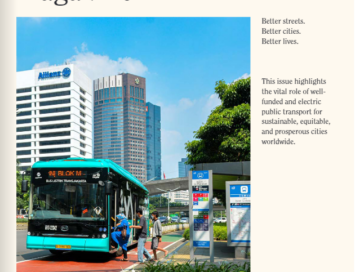The Path Less Travelled: Scaling Up Active Mobility to Capture Economic and Climate Benefits
About
In the years since the start of the COVID-19 pandemic, many cities and countries have taken action to position and promote active mobility—cycling and walking—as transport modes. Demand for active mobility during the pandemic skyrocketed, and cities and governments responded by making more space on streets, providing free access to bikeshare systems, and allocating budgets to bicycle purchase incentives.
More and more cities worldwide are interested in building cycle lanes and pedestrian networks that improve access to public transportation and enable low-carbon mobility. However, due to chronic under-valuing and under-investment in cycling, few cities outside Northern Europe have a complete network of protected bicycle lanes or the sustained funding needed to develop and maintain cycle infrastructure at scale.
This paper from ITDP and the World Bank, The Path Less Travelled, makes a case for scaling up financing for active mobility, leveraging best practices, and identifying and replicating successful investment mechanisms based on several case studies. The return on investment for bicycle infrastructure networks is high—both in terms of the network effects from supporting broader transport investments like metro or bus rapid transit (BRT) and the related climate, health, and economic benefits.
Because it is relatively quick to build compared to other transport infrastructure, cycle networks can generate more climate, health, and economic benefits in the near term, often paying for itself in just a few years. Thus, cycle infrastructure networks are one of the most cost-effective strategies to reduce greenhouse gas emissions from the urban passenger transport sector.
Governments, financial institutions, and philanthropic and civil society organizations seeking to increase investment in climate-friendly, active mobility projects must build coalitions and take a holistic view of active mobility as a key component of urban transport and development. The World Bank and ITDP also released a complementary report and tool in 2025, The Case for Cycling Infrastructure Investments.
Based on a review of five city case study projects—Addis Ababa, Buenos Aires, Dar es Salaam, Lima, and Tianjin—the paper presents calls to action for development banks, city and national governments, and philanthropy and civil society organizations to help coordinate and scale investment in active mobility infrastructure. While national and city governments are responsible for implementing infrastructure, development banks, philanthropic organizations, and civil society organizations must also take action to help advance and scale needed financing and technical assistance for cycle infrastructure.
Ultimately, investment in active mobility infrastructure supports other crucial sustainable transport goals, such as improving road safety and expanding access to and ridership of BRT and metro. For cities to harness the full potential of cycling and its related infrastructure, there needs to be more multi-sector collaboration, policymaking, and resource allocation towards sustainable mobility projects as a whole.

Opportunities For Action
| Key Financial Players | Key Actions for Scaling Up Investment in Active Mobility |
| Development banks Multilateral and bi-lateral banks | • Improve project design requirements to include and track active mobility investments in urban transport projects • Adopt a standardized CBA methodology and toolkit for active mobility infrastructure • Increase funding towards a coordinated effort to help build knowledge and capacity within national and city governments to design and implement active mobility networks |
| City governments | • Develop (or update) an active mobility network plan that demonstrates a clear vision for how active mobility aligns with urban development, public health, climate, and related goals • Consider seeking grant funding from development banks, philanthropy, and others to develop a cycle network plan and/or evaluate CBA • Communicate the benefits of active mobility with the public and other road users to build support • Design and fund (or seek financing for) programs that support cycling (i.e., bikeshare, secure parking, car-free events) |
| National governments | • Develop (or update) a national active mobility plan that delivers multimodal transportation options • Coordinate with transport and planning authorities to develop planning guidelines and design standards that incorporate active mobility • Seek financing from development partners for active mobility network plan implementation • Require roads projects to include cycle and pedestrian infrastructure to qualify for national funding • Tie eligibility of local authorities for national funding to active mobility budget targets |
| Philanthropy and civil society organizations | • Contribute to CBA methodology standardization efforts and data collection to make the case for active mobility infrastructure investments • Provide technical assistance to governments to develop and implement active mobility network plans • Coordinate key stakeholders to identify and address knowledge, data, and financing gaps |
Interested in learning more about our research or have a press inquiry? Email us at [email protected].




